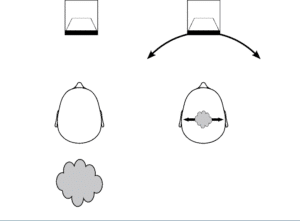The unique quality of the head geometry and pinnae makes the head-related transfer functions (HRTF) highly idiosyncratic. It’s imperative to represent these characteristics during a spatial audio rendering; however, with the strenuous measurement process, large dataset, and desired flexibility of virtual acoustic systems, it is difficult to use the individualized HRTF. Modeling has come to the forefront of research to compensate for the cumbersome nature of the individualized HRTF full dataset. Despite the progress in modeling, the non-individualized HRTF comes with limitations. The generic HRTF has various perceptual consequences, such as front-back confusion and lateralization , that the listener may experience.
Front-back confusion has the listener perceive the virtual sound source in the reverse horizontal half-plane as the intended source localization. Supplementary to the non-individualized HRTF, the binaural rendering techniques influences perceived direction as well. A binaural reproduction using headphones is perceived behind the head. With a transaural loudspeaker reproduction, the perceived direction is in the front, revealing a visual component. This confusion may also occur in the vertical plane but has been less studied.
The listener perceiving a virtual sound source intracranially is defined as lateralization or inside-of-head localization. This is a result of the auditory system failing to extract auditory cues from the ear input signal. The location of the intracranial signal is presented on a one-dimensional axis inside the head, connecting the two ears. The location along the axis is a function of interaural time difference and interaural level difference.

Figure 1. Illustration of perceptual consequences. The speaker is the targeted source direction and the cloud is the perceived source direction. (Left) Front-back confusion.(Right) Lateralization of the sound source instead localization, which is represented with the curved line.Here, you see lateralization is one-dimensional while localization is three-dimensional.
More Information